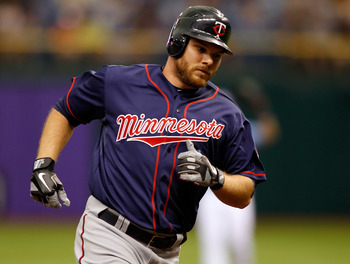Following reports of the Minnesota Twins inking right-handed-starter Ricky Nolasco to a four-year, $49 million deal
http://www.mlbtraderumors.com/2013/11/twins-agree-to-terms-with-ricky-nolasco.html, it's time to further delve into the remaining starting pitching options on the free agent market. Prior to the terms of Nolasco's new deal with Minnesota becoming available to the public, many Twins fans are aware that the previous most-lucrative free agent deal in club history was a three-year, $21 million deal with Josh Willingham during the 2011 offseason. The recent deal with Nolasco trumps this two-year-old record by more than five million per season.
One could consider the Nolasco deal a sign of new things to come in Twins Territory, as Terry Ryan, the acting GM of the Minnesota Twins, isn't known for spending considerable dollar amounts on the free agent market. This trend considered, Gavin Floyd appears to be as likely a target as anybody else on the market for Ryan.
Gavin Floyd, a serviceable, 30-year-old, 10-year vet and current unrestricted free agent, would be the type of signing that Twins fans have become accustomed to under Ryan. Floyd is coming off a vastly shortened campaign in 2013, which saw him undergo Tommy John Surgery in early May after making just five starts in order to repair a torn ulnar collateral ligament in his right elbow and a torn flexor muscle in the same arm.
Terry Ryan has a history of buying-low on players with some level of upside, as he inked Mike Pelfrey, who was coming off a similar injury, to a one-year, low-salary deal worth $4 million with incentives this past offseason. A deal with Floyd should look fairly similar, as both veterans hold a career ERA of 4.48, and similar FIPs- 4.39 and 4.17 respectively, according to
http://www.fangraphs.com/. Floyd's situation and its relation to Ryan's recent acquisition of Pelfrey makes Floyd a realistic target, as the Twins should have no issue finding the financial resources required to nab his services- especially considering the type of money shelled out for Nolasco just days ago.
This type of signing may not be the kind Twins fans clamor for, as his career numbers aren't too different than Mike Pelfrey's, who didn't exactly become the topic of positive Twins-related conversations this past summer. As mentioned earlier, Floyd's career FIP is inferior to Pelfrey's, but when healthy he's able to strike out batters at a higher rate than Pelfrey, as seen by their career K/9 numbers of 7.06 and 5.21 respectively; these stats as well as the following according to
http://www.fangraphs.com/. Throughout his career, Floyd has allowed close to league-average in terms of base runners, shown by his 1.34 WHIP. He's allowed an underwhelming home run to fly ball ratio of 11.9 percent for his career, but be mindful that many of these innings were pitched at his previous home park, the hitter-friendly U.S. Cellular Field. Target Field, a pitcher-friendly park, should allow him to lower his HR/FB substantially.
Prior to Pelfrey undergoing Tommy John surgery in 2012 and Floyd in 2013, between the years of 2008 and 2011, the difference between each pitcher in terms of averaged innings pitched per season is less than just one inning. Pelfrey has the slight edge, averaging 195.4 innings per season during this span over Floyd's 194.9, which were calculated using compiled data on
http://www.fangraphs.com/. It may be worth noting that during this span, Pelfrey pitched in the National League for the Mets while Floyd pitched in the American League for the White Sox, so pinch hitters for Pelfrey's spot in the lineup during games played in NL parks may have cost him some innings in the long run.
Terry Ryan signed Mike Pelfrey last season in part because he came at a low cost; however, even after a down year in 2013 which saw him post a 5.19 ERA - the current unrestricted free agent may be poised for a slight salary increase in 2014, as he showed considerable progression last season with the return of his velocity - he averaged 92.3 mph on his fastball in 2013, just 0.20 mph less than his career average - as well as a more performance-indicative FIP of 3.99 and an overall improved second half of the season. Pelfrey was also the league's third-most unlucky pitcher in 2013 by ERA-FIP standards, according to
http://grubulub.com/who-got-lucky-in-2013/.
Throughout his career, Gavin Floyd has similar velocity numbers to Pelfrey, as he's averaged 91.6 mph on his fastball to Pelfrey's 92.5 mph. Possibly more importantly, Floyd was averaging 91.4 mph on his fastball before leaving for injury in 2013, which could signify that he'll return with similar velocity as Pelfrey was able to post surgery. Pelfrey returned with good velocity in 2013, but was also throwing with some heat before leaving for injury, as he was averaging 92.9 mph on his fastball in 2012, only 0.60 mph better than he showed in 2013.
Assuming that Gavin Floyd receives a contract this offseason and that it contains less guaranteed salary than Pelfrey gets on a new deal, Ryan may find more value in Floyd than in Pelfrey. For this to come true, Floyd will need to regain his former velocity and continue to strike batters out consistently, while staying close to most of his other career norms. According to
http://www.fangraphs.com/, Floyd has arguably been more valuable than Pelfrey since coming into the league, as he's been worth 15.6 wins above replacement in his career (WAR) to Pelfrey's 10.2. Pelfrey reminded us last season that Tommy John-related injuries are becoming increasingly easier to come back from, so a successful campaign for Floyd in 2014 may be more likely than not.
If the Twins sign Gavin Floyd to a deal this offseason it will almost assuredly be clear that his medicals checked out and they believe he'll be able to contribute effectively at a major-league level sometime in 2014. Terry Ryan may have shown an elevated interest in a quick turnaround through his signing of Ricky Nolasco, which may result in another signing similar to Nolasco's caliber- meaning he doesn't feel the starting rotation has been improved enough to this point. Regardless of whether this is the case or not, a Gavin Floyd signing should be low-risk and offer the Twins quality starting pitching depth- something they've lacked for a long time and will need before they're playoff contenders again.








